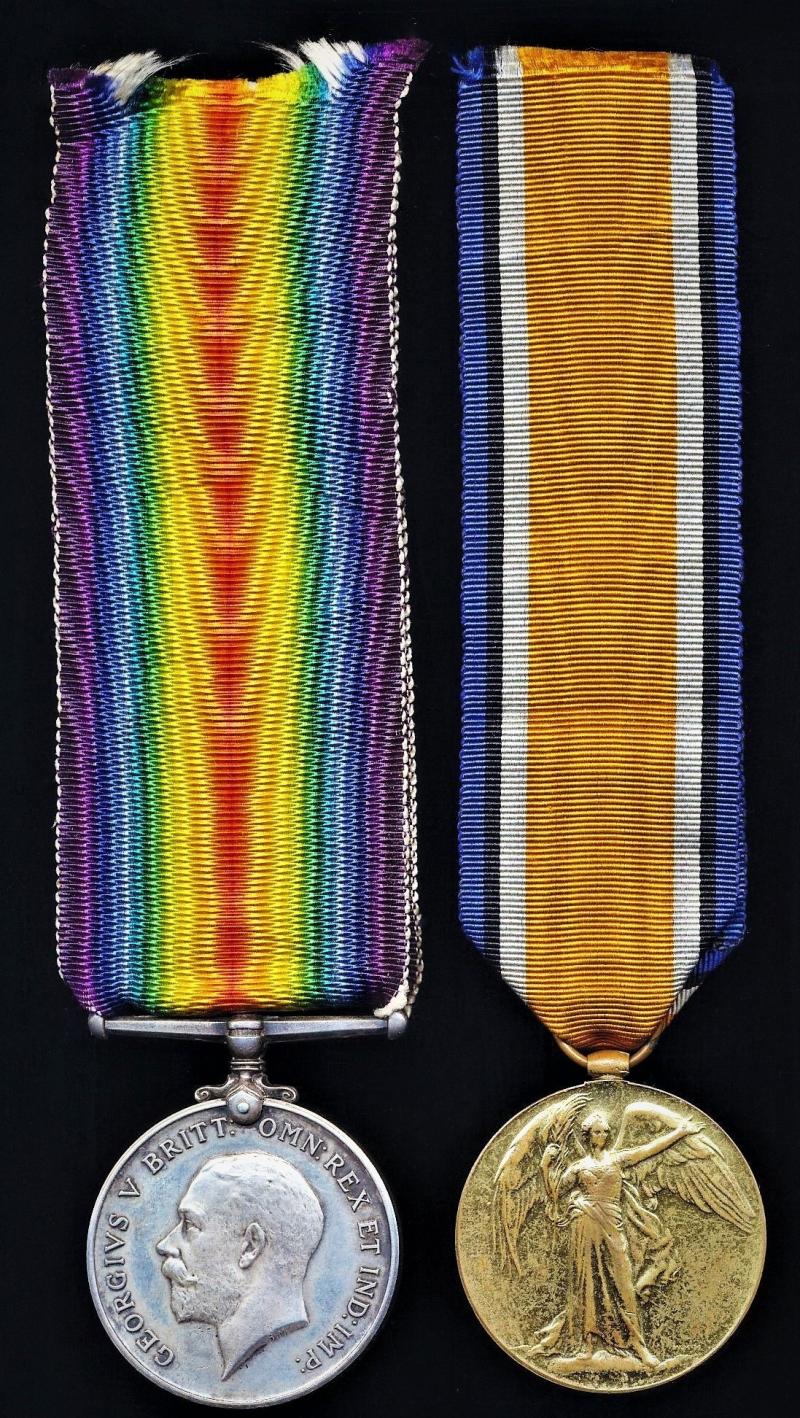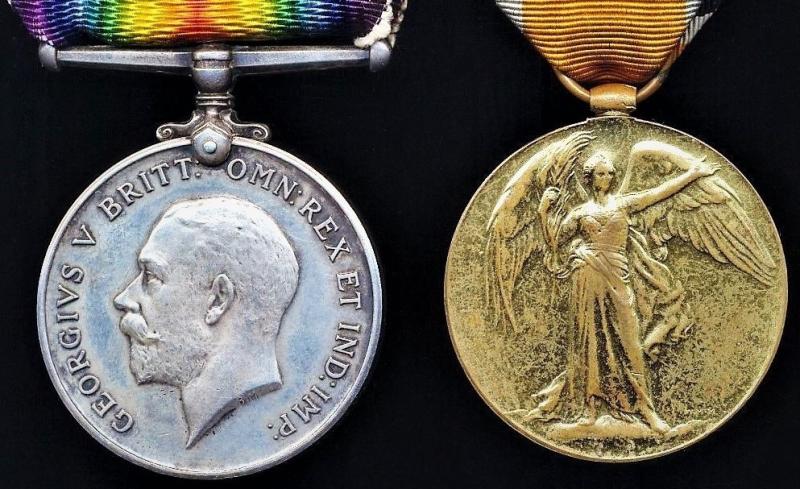A 'Stocksbridge' Digger's Wounded at Gallipoli later Killed-in-Action France during a Victoria Cross Action, Great War campaign medal pair: Private Ernest Watson, 13th Infantry Battalion, Australian Imperial Force
- British War Medal. Silver issue (688 Pte. E. Watson. 13-Bn. A.I.F.)
- Interallied Victory Medal (688 Pte. E. Watson. 13-Bn. A.I.F.)
Wounded-in-Action Gallipoli: Private Ernest Watson 13th Infantry Battalion A.I.F., is confirmed having bene wounded-in-action at Gallipoli by Gunshot & Shrapnel Wound (G.S.W.). on 1915, while fighting the Ottoman Turkish Army
Killed-in-Action at Victoria Cross Action: Private Ernest Watson 13th Infantry Battalion A.I.F., is confirmed having been killed-in-action on 4 February 1917, at Gueudecourt, France, while fighting the German Army
The Commonwealth War Graves Commission maintain records - and memorials - of 49 x 'All-Ranks' of the 13/AIF who are recorded as having been Killed-in-Action or Died-of-Wounds, on 4 February 1917
The memory of the life & supreme sacrifice of Private Ernest Watson 13th Battalion Australian Imperial Force is commemorated in perpetuity by the Commonwealth War Graves Commission, on a panel on the Australian National Memorial located within the Villers-Bretonneux Military Cemetery
The memorial is the Australian National Memorial erected to commemorate all Australian soldiers who fought in France and Belgium during the First World War, to their dead, and especially to name those of the dead whose graves are not known
The Australian servicemen named on this memorial died on the battlefields of the Somme 1916-18, Pozieres, Bapaume 1917, Arras 1917, Bullecourt, Messines 1917, Ypres 1917, Menin Road, Polygon Wood, Broodseinde, Poelcappelle, Passchendaele, Avre, Ancre 1918, Villers-Bretonneux, Lys, Hazebrouck, Hamel, Marne 1918, Amiens, Albert 1918, Albert 1918 (Chuignes), Mont-St. Quentin, Hindenburg Line, Epehy, St. Quentin Canal and Beaurevoir
Both the cemetery and memorial were designed by Sir Edwin Lutyens. The memorial was unveiled by King George VI on 22 July 1938
Of the 10,982 names displayed at the unveiling of the Villers-Bretonneux Memorial the burial places of many have since been identified and this continues to this day. As a result, there are currently 10,729 Australian servicemen officially commemorated by this memorial
Notwithstanding that we do not know the company of the 13/AIF that Ernest served-in on 4th February 1917 (he is known to have been serving with 'C' Company in 1916). We would refer clients to the unit's excellent battalion war diary, and to the Victoria Cross citation of the legendary ANZAC hero 'Harry Murray 'for truly inspirational insight to the outstanding performance of 13/AIF at Guedecourt, France. After the battle, the Officer Commanding wrote a detailed report of the action (three Victoria Cross recommendations - only one of which resulted in an award of the VC), which included a summary of highlights including, the remark:
Quote
The bayonet was too much for the Germans in this fight, they either surrendered or fled, when called on to face it
Unquote.
The Victoria Cross citation detailing the exceptional gallantry of Harry Murray (Australia's most decorated soldier of the Great War) on 4 February 1917, states:
Quote,
For most conspicuous bravery when in command of the right flank company in attack. He led his company to the assault with great skill and courage, and the position was quickly captured. Fighting of a very severe nature followed, and three heavy counter-attacks were beaten back, these successes being due to Captain Murray’s wonderful work. Throughout the night his company suffered heavy casualties through concentrated enemy shell fire, and on one occasion gave ground for a short way. This gallant officer rallied his command and saved the situation by sheer valour. He made his presence felt throughout the line, encouraging his men, heading bombing parties, leading bayonet charges, and carrying wounded to places of safety. His magnificent example inspired his men throughout.
Unquote
Note: Lieutenant-Colonel Harry Murray, V.C., C.M.G., D.S.O. (& bar), D.C.M, 4 x Mentioned-in-Despatches, and France Croix De Guerre, was the most decorated Australian soldier of the Great War!
13/AIF Honours and Awards: During the Great War, the Battalions soldiers received the following awards: 1 VC; 1 CB; 1 CMG; 5 DSO; 1 MVO; 34 MC, 2 bars, 1 2nd bars; 35 DCM; 152 MM ,11 bars, 1 2nd bar; 4 MSM; 1 Albert Medal; 52 MID; 5 foreign awards
Ernest Watson, third son, of William Parks Watson (a Miner - Colliery Pump Attendant) & Caroline Watson (nee Lord), was a native of Stocksbridge, Yorkshire, England, where he was born in 1888. Born into a mining community and a mining family, Ernest like his father before him, worked as Coal Miner from at least the age of 15 years (the 1901 National Census for England & Wales refers). Growing-up Ernest was surrounded with a large family, comprising his parents and 8 x siblings, comprising 2 x older brothers, and 6 x sisters. By the time of the compilation of the 1911 National Census for England and Wales, Ernest is recorded as a Coal Miner 'Hewer', residing with his retired widowed father, and 3 x younger sisters; Helen Rosella Watson (23, Elementary School Teacher); Florence Hilda Watson (19, Umbrella Factory Worker), at the family residence located at, Hawthorne Brook, Stocksbridge, nr Sheffield, Yorkshire, England. Ernest migrated to Australia, sometime after April 1911, and was a resident in New South Wales - working as a Miner - when he volunteered for service with the Australian Imperial Force, at Sydney, on 18 September 1914, and subsequently posted to 13th Battalion Australian Imperial Force
After completion of basic training (Ernest cited prior service with a Militia unit) Ernest embarked for overseas service aboard the H.M.A.T. 'Ulysses' that sailed from Sydney on, 22 December 1914 bound for Egypt. Ernest subsequently served at Gallipoli, where he was wounded-in-action, by GSW on, 5 May 1915, and evacuated thereafter. Ernest appears to have been an ideal cultural fit for the AIF, as like many of his 'Digger' mates, he had several run-in's with military authority, including neglecting to obey an order while on active service, and 'drunkenness', these latter accruing for Ernest, 2 x periods of 'No 2 Field Punishment' for his transgressions. Ernest is recorded as being killed-in-action at, Guedecourt, France, on, 4 February 1917
Both medals retaining their original long lengths of silk 'moire' ribands, fitted 'reverso' on the medals, as commonly found on Great War medals
A fine pair of medals to an English Digger' who saw hard fighting at Gallipoli and who later paid the supreme sacrifice during a famous Australian Victoria Cross action in France, while serving with the Australian Imperial Force
Condition: About EF
Code: 22878







